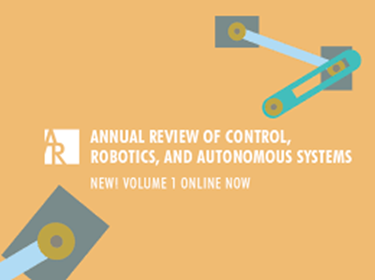密集非结构化交通中自主主体的本能协商:控制视角
IF 14
1区 计算机科学
Q1 AUTOMATION & CONTROL SYSTEMS
Annual Review of Control Robotics and Autonomous Systems
Pub Date : 2023-11-14
DOI:10.1146/annurev-control-060923-025701
引用次数: 0
摘要
在非结构化空间中操作自主代理是一个难题。决策的复杂性,比如什么时候退让,什么时候继续,随着代理的数量呈指数增长。对于人类和控制自主代理的软件来说都是如此。然而,经过一些实践,人类操作员能够在密集交通中由相互作用的代理组成的迷宫中有效地移动。最近的一个结果将多智能体系统的不稳定性与不存在僵局联系起来。这些基于控制障碍函数的算法不包括决策组件——动作是连续的,协商发生在不稳定性中。这种机制被称为本能协商,与非凸优化引起的非连续性决策形成对比。基于观察到的行为相似性和对人类内隐和外显学习的见解,本文提出了与人类驾驶的联系,并提出人类可能采用类似于本能协商的机制来驾驭密集的交通。预计《控制、机器人和自主系统年度评论》第七卷的最终在线出版日期是2024年5月。修订后的估计数请参阅http://www.annualreviews.org/page/journal/pubdates。本文章由计算机程序翻译,如有差异,请以英文原文为准。
Instinctive Negotiation by Autonomous Agents in Dense, Unstructured Traffic: A Controls Perspective
Operating autonomous agents in unstructured space presents a difficult problem. The complexity of making decisions such as when to yield and when to go ahead increases exponentially with the number of agents. This is true for humans as well as for software that controls autonomous agents. With some practice, however, human operators are able to move efficiently in a maze of interacting agents in dense traffic. One recent result correlates the instability of equilibria in a multiagent system with an absence of gridlocks. These control barrier function–based algorithms do not include a decision-making component—the action is continuous, and negotiation happens through instability. This mechanism, referred to as instinctive negotiation, is contrasted with discontinuity-induced decisions arising from nonconvex optimization. Based on observed behavioral similarities and insights into human implicit and explicit learning, this article proposes a connection with human driving and suggests that humans may employ a mechanism similar to instinctive negotiation to navigate dense traffic. Expected final online publication date for the Annual Review of Control, Robotics, and Autonomous Systems, Volume 7 is May 2024. Please see http://www.annualreviews.org/page/journal/pubdates for revised estimates.
求助全文
通过发布文献求助,成功后即可免费获取论文全文。
去求助
来源期刊
CiteScore
28.30
自引率
2.20%
发文量
25
期刊介绍:
The Annual Review of Control, Robotics, and Autonomous Systems offers comprehensive reviews on theoretical and applied developments influencing autonomous and semiautonomous systems engineering. Major areas covered include control, robotics, mechanics, optimization, communication, information theory, machine learning, computing, and signal processing. The journal extends its reach beyond engineering to intersect with fields like biology, neuroscience, and human behavioral sciences. The current volume has transitioned to open access through the Subscribe to Open program, with all articles published under a CC BY license.

 求助内容:
求助内容: 应助结果提醒方式:
应助结果提醒方式:


